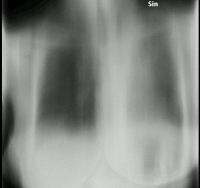
Photo from wikipedia
Importance Fusarium keratitis is common and often results in poor outcomes. No new treatments since natamycin have become available. Objective To explore the role of adjuvant oral voriconazole on clinical… Click to show full abstract
Importance Fusarium keratitis is common and often results in poor outcomes. No new treatments since natamycin have become available. Objective To explore the role of adjuvant oral voriconazole on clinical outcomes in Fusarium keratitis. Design, Setting, and Participants In this prespecified subgroup analysis of a multicenter, double-masked, placebo-controlled randomized clinical trial, 240 patients from the Aravind Eye Care System in India, the Lumbini Eye Hospital and Bharatpur Eye Hospital in Nepal, and the University of California, San Francisco, who had culture-positive fungal ulcer and baseline visual acuity of 20/400 or worse were randomized to receive oral voriconazole vs placebo. Enrollment started May 24, 2010, and the last patient study visit was November 23, 2015. All patients received topical voriconazole, 1%, and after the results of the Mycotic Ulcer Treatment Trial (MUTT) II became available, topical natamycin, 5%, was added for all patients. Data analysis was performed from September 2 to October 28, 2016. Main Outcomes and Measures The primary outcome of the trial was the rate of corneal perforation or the need for therapeutic penetrating keratoplasty. Secondary outcomes included rate of reepithelialization, best spectacle-corrected visual acuity, and infiltrate or scar size at 3 months. Results Of the 240 study participants, 72 (30.4%) were culture positive for Fusarium species (41 [56.9%] male and 31 [43.1%] female; median [interquartile range] age, 50 [45-57] years). Of these, 33 (45.8%) were randomized to oral voriconazole and 39 (54.2%) to placebo. Fusarium ulcers randomized to oral voriconazole had a 0.43-fold decreased hazard of perforation or therapeutic penetrating keratoplasty compared with placebo after controlling for baseline infiltrate depth (95% CI, 0.22-fold to 0.84-fold; P = .01). Multiple linear regression revealed a 1.89-mm decreased infiltrate and/or scar size at 3 weeks (95% CI, −2.69 to −1.09 mm; P < .001) and a 0.83-mm decreased infiltrate and/or scar size at 3 months after correcting for baseline values (95% CI, −1.33 to −0.32 mm; P = .001) in eyes randomized to oral voriconazole vs placebo. Eyes treated with oral voriconazole also had a mean 0.29 decreased logMAR (improved) (Snellen equivalent 20/40) visual acuity at 3 months after controlling for baseline visual acuity, although this finding was not statistically significant (95% CI, −0.57 to 0.002; P = .052). Conclusions and Relevance Although MUTT II could not find a benefit for all corneal ulcers, Fusarium keratitis may benefit from the addition of oral voriconazole to topical natamycin, and physicians should consider prescribing oral voriconazole in these cases. Trial Registration clinicaltrials.gov Identifier: NCT00996736
Journal Title: JAMA Ophthalmology
Year Published: 2017
Link to full text (if available)
Share on Social Media: Sign Up to like & get
recommendations!